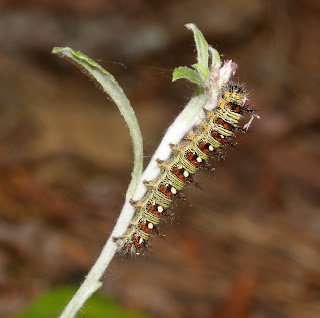In the spring new stuff is coming out every day, and I think, Ah, a lot of new stuff to report in my blog. But then, a lot of newer stuff comes out, and instead of writing about it, I go out and find a lot of even newer stuff. By the time you get a chance to write about last week's new stuff, it's old news.
So, for whatever value it still has, on May 1st around the house we saw these poor caterpillars in their first instar, the remnants of the eggs they hatched from still on the leaf near them. They are Prominents of some kind, but too small to guess the species. I measured them, and they are barely 5 mm long. This will show you what caterpillars are up against: If you look closely, you will see they are already covered with eggs of what must be a very small species of parasitic Tachinid fly. (Fair play: This is what Tachinids are up against: When I looked the next day they were all gone, eaten perhaps by a bird.)
Other sightings around the house: This quite wonderful jumping spider mimicking an ant. His steady exploratory walking was exactly like an ant's. He walked on his last six legs, and waved his front legs in front of him like antennae. Even the shape of his abdomen is lumpy to resemble the the multiple gasters on many southern ant species.
An obvious question is: Why does he imitate an ant? Well, I suppose ants don't have much meat on them, and probably taste like formic acid, so not many things eat them. That might be a kind of defense. And some ants bite and sting; that might discourage predators. But the possibility I like best is, some ant-mimic spiders hang out next to a line of ants, looking as much as they can like one of the guys, and then pop in and grab one when no one is looking.
The spring Robber Flies are mostly in by now, and the earliest summer ones are showing up. For instance, May 1st we suddenly had a number of Atomosia puella in our yard. You only notice these if you are an enthusiast. Some Robber Flies are almost two inches long, but Atomosia is at the other extreme, at 6-8 mm. If you aren't deliberately looking, you miss them altogether. They nevertheless have a lot of personality. If you see one, you will probably see several in the neighborhood. They sit, head down, on the walls of you house, on telephone poles, tree trunks, or other upright, preferably wood structures, and fly up constantly and bring back flying aphids or termites or tiny flies. They surprise you by pointing out how many tiny things are constantly in the air. The females do most of this bug-catching. The even tinier males spend their time doing hovering courtship flights about an inch away from the females. Here's a female on the side of a treetrunk eating some tiny thing while a male hovers hopefully nearby:
May 2nd we went up to Crowley's Ridge State Park in Greene Co. and walked a trail where, if it were going to be a Hairstreak year, they would show up first. And it was teeming with them, males sitting at the tip of every bush we passed, constantly flying up to dog-fight with the male on the next bush, sometimes three or more swirling around and around before returning to their perches. It was going to be a Hairstreak year.
We checked every one of them, but they were all Banded Hairstreaks, the commonest species. But other people around the state were beginning to find more unusual species, Oak Hairstreaks, White M Hairstreaks. No telling what might eventually show up, perhaps the hard-to-identify Hickory Hairstreak, or the rare Edwards's Hairstreak, or, if we get down to the southern part of the state, the King's Hairstreak. Here's the Banded. All the others will be some slight variation on this standard pattern.
Another butterfly was evident: An American Lady was laying eggs on the cudweed along the edge of the path. We looked and finally found one of the very attractive American Lady caterpillars.
There were also some spring Robber Flies along the trail, several mating pairs, for instance, of Machimus virginicus, one of a number of species in the Machimus genus. This one is identified by having only a tiny amount of orange at the base of its tibiae.
Best of all, we found a Neoitamus flavofemoratus sitting quietly beside the path. The diagnostic mark for this genus is that the hair on the back of the head curls forward (very stylishly). I had long wanted to get a close-up picture in just the right position to show this. This one posed beautifully for us (Cheryl holding my hat behind it to create a little contrast).









No comments:
Post a Comment